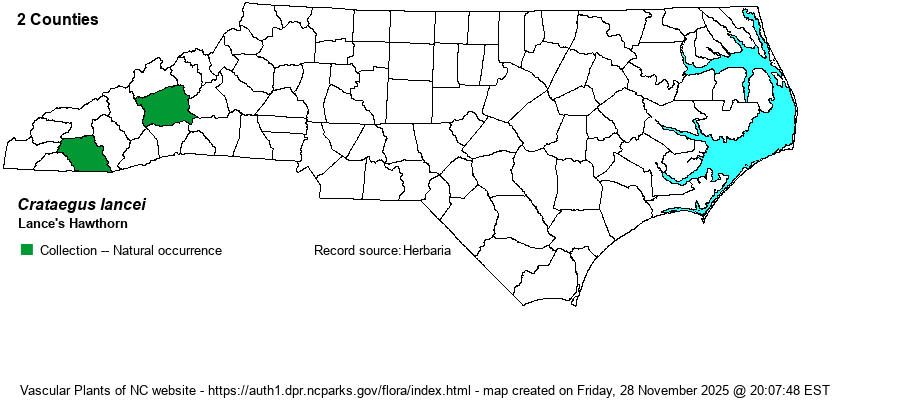| Author | J.B. Phipps | |
| Distribution | May have a disjunct range in the state, being sparingly found from Buncombe County south into northwestern SC, and then again in the Sandhills region of the Coastal Plain. It ought to occur between these areas, such as in the Piedmont, but Lance’s (2014) map does not shade the Piedmont of the Carolinas in the range – as yet. On the other hand, Weakley (2018) does show it as occurring in the NC Piedmont in his regional map. Needless to say, the range map below might be grossly under-populated, as the SERNEC database shows collections from just Buncombe and Macon counties, so far. Without more counties of collection, the website editors must consider it a species only of the southern Mountains for now.
A recently described taxon that is poorly known. Weakley (2018) describes the overall range as: “S. NC to e. GA, with outlier populations reported from sw. GA, n. peninsular FL and se. AL. Appears to have a core range in w. SC and ne. GA, sporadic elsewhere in a fragmented range that involves broad areas devoid of specimens.”
| |
| Abundance | Lance (2014) considers it as rare in the state. However, Weakley (2018) shows it “uncommon” in the NC Piedmont, but "rare" in the other provinces. The Flora of North America species account says it is “fairly common from Alabama to the Carolinas and northern Florida”. This is a Watch List species. | |
| Habitat | This is a species of upland sites, typically in dry ones, such as pine-oak sandhills, upland thickets and pastures, and other non-wetland sites. It apparently favors partial sun. As this is a recently described species, detailed information on habitat is still incomplete. |
| Phenology | Blooms in April and May, and fruits in August and September. | |
| Identification | This is a large shrub or small tree, often with drooping branches. First-year twigs are quite hairy to tomentose. The leaves are narrowly obovate with strongly cuneate bases; thus the leaves are a bit fan-shaped. Also, the serrations on the outer half tend to be rounded such that the outer portion (the “fan”) is scalloped and not deeply jagged. See Lance (2014) and Weakley (2018) for more details. As C. flava is no longer a valid species, having been split up into a few “new” species, it is possible, if not likely, that some or many of the individuals that biologists have seen and identified previously as C. flava could well be C. lancei. | |
| Taxonomic Comments | Though this species was only described in 2008, and named for Ron Lance, who wrote the primarily hawthorn reference book in 2014, Weakley (2018) suggests that forms of it were included within the very broad C. flava in RAB (1968). As with C. flabellata, C. flava has now been split up into a number of “new” species and thus no longer exists. Not surprisingly, NatureServe has not yet given this taxon a Global Rank.
| |
| Other Common Name(s) | Lance Hawthorn | |
| State Rank | S1S2 | |
| Global Rank | GNR | |
| State Status | W7 | |
| US Status | | |
| USACE-agcp | | |
| USACE-emp | | |

